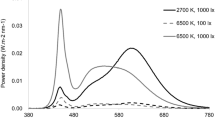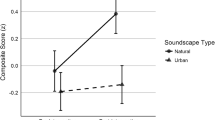Abstract
Three studies examined the effects of key aspects of indoor lighting (illuminance, spectral distribution) on the performance of tasks that did not primarily involve visual processing. It was hypothesized that lighting conditions which generated positive affect among subjects would influence behavior and cognition in ways consistent with the findings of previous research on the influence of such affect. Results of all three studies offered partial support for this hypothesis. In Study 1, male and female subjects exposed to relatively low levels of illuminance (150 lux) assigned higher performance appraisals to a fictitious employee and included a broader range of words in specific word categories than subjects exposed to relatively high levels of illuminance (1500 lux). In Study 2, subjects exposed to warm white light reported stronger preferences for resolving interpersonal conflicts through collaboration and weaker preferences for resolving conflicts through avoidance than subjects exposed to cool-white light. Additionally, illuminance and spectral distribution (color) interacted to influence subjects' self-set goals on a clerical coding task. In Study 3, receipt of a small, unexpected gift and exposure to warm-white light both increased the amount of time subjects were willing to donate as unpaid volunteers. In addition, in the absence of a gift, subjects volunteered more time under low than under high illuminance.
Similar content being viewed by others
References
Anderson, C. A. (1989). Temperature and aggression: Ubiquitous effects of heat on occurrence of human violence.Psychological Bulletin, 106 74–96.
Baddeley, A. (1990).Human memory. Boston: Allyn & Bacon.
Baron, R. A. (1978). Aggression and heat: The “long hot summer” revisited. In A. Baum, S., Valins, & J. E. Singer (Eds.),Advances in environmental research (Vol. 1). Hillsdale, NJ: Erlbaum.
Baron, R. A. (1983). The control of human aggression: A strategy based on incompatible responses. In R. G. Geen & E. I. Donnerstein (Eds.),Aggression: Theoretical and empirical reviews. New York: Academic Press.
Baron, R. A. (1984). Reducing organizational conflict: An incompatible response approach.Journal of Applied Psychology, 69 272–279.
Baron, R. A. (1987). Mood of interviewer and the evaluation of job candidates.Journal of Applied Social Psychology, 17 911–926.
Baron, R. A. (1988). Negative effects of destructive criticism: Impact on conflict, self-efficacy, and task performance.Journal of Applied Psychology, 73 199–207.
Baron, R. A. (1990). Conflict in organizations. In K. R. Murphy & F. E. Saal (Eds.).Psychology in organizations: Integrating science and practice. Hillsdale, NJ: Erlbaum.
Baron, R. A., Fortin, S. P., Frei, R. L., Hauver, L. A., & Shack, M. L. (1990). Reducing organizational conflict: The potential role of socially-induced positive affect.International Journal of Conflict Management, 1.
Belcher, M. C., & Kluczny, R. (1987). The effects of light on decision making: Some experimental results (pp. 354–357).Proceedings of CIE. Venice.
Bell, P. A., & Fusco, M. E. (1989). Heat and violence in the Dallas field data: Linearity, curvilineary, and heteroscedasticity.Journal of Applied Social Psychology, 19 1479–1482.
Biner, P. M. (1991). Effects of lighting-induced arousal on the magnitude of goal valence.Personality and Social Psychology Bulletin, 17 219–226.
Biner, P. M., Butler, D. L., Riscsher, A. R., & Westergren, A. J. (1989). An arousal optimization model of lighting level preferences: An interaction of social situation and task demands.Environment and Behavior, 21 3–16.
Blackwell, H. R. (1959). Development and use of a quantitative method for specification of interior illuminating levels on the basis of performance data.Illuminating Engineering, 54 317–353.
Blehar, M. C., & Rosenthal, N. E. (Eds.). (1989).Season affective disorders and phototherapy. New York: Guilford Press.
Boyce, P. R. (1981).Human factors in lighting. New York: Macmillan.
Boyce, P. R., Berman, S. M., Collins, B. L., Lewis, A. L., & Rea, M. S. (1989).Lighting and human performance: A review. Lighting Equipment Division, National Electrical Manufacturers Association and Lighting Research Institute.
Butler, D. L., & Biner, P. M. (1987). Preferred lighting levels: Variability among settings, behaviors, and individuals.Environment and Behavior, 19 695–721.
Cardy, R. L., & Dobbins, G. H. (1986). Affect and appraisal accuracy: Liking as an integral dimension in evaluating performance.Journal of Applied Psychology, 71 672–678.
Carnevale, P. J. D., & Isen, A. M. (1986). The influence of positive affect and visual access on the discovery of integrative solutions in bilateral negotiation.Organizational Behavior and Human Decision Processes, 37 1–13.
Cohen, S., Evans, G. W., Krantz, D. S., & Stokols, D. (1980). Physiological, motivational, and cognitive effects of aircraft noise on children.American Psychologist, 35 231–243.
Cohen, S., Evans, G. W., Stokols, D., & Krantz, D. (1986).Behavior, health, and environmental stress. New York: Plenum Press.
Cunningham, M. R., Shaffer, D. R., Barbee, A. P., Wolff, P. L. & Kelley, D. J. (1990). Separate processes in the relation of elation and depression to helping: Social versus personal concerns.Journal of Experimental Social Psychology, 26 13–33.
Davis, R. G., & Ginthner, D. (1990). Correlated color temperature, illuminance level, and Kruithof curve.Journal of the Illuminating Engineering Society, 19 27–38.
Fiedler, K., & Forgas, J. P. (Eds.). (1988).Affect, cognition, and social behavior. Toronto: Hogrefe.
Fisher, J. D., Bell, P. A., & Baum, A. (1990).Environmental psychology (3rd ed.). New York: Holt, Rinehart, & Winston.
Flynn, J. E. (1977). A study of subjective responses to low energy and nonuniform lighting systems.Lighting Design and Application, 7 6–15.
Flynn, J. E., Spencer, T. J., Martyniuk, O., & Hendrick, C. (1973). Interim study of procedures for investigating the effect of light on impression and behavior.Journal of the Illuminating Engineering Society, 3 87–94.
Garner, W. R., Hake, H. W., & Eriksen, C. W. (1956). Operations and the concept of perception.Psychological Review, 63 149–159.
George, J. M. (1989). Mood and absence.Journal of Applied Psychology, 74 317–324.
George, M. M. (1990). Personality, affect, and behavior in groups.Journal of Applied Psychology, 75 107–116.
Gifford, R. (1988). Light, decor, arousal, comfort and communication.Journal of Environmental Psychology, 8 177–189.
Illuminating Engineering Society of North America (1987).Illuminating Engineering Society Handbook: Application Volume. New York: Kaufman, J. E. and Christensen, J. F. (eds.).
Isen, A. M. (1970). Success, failure, and reaction to others: The warm glow of success.Journal of Personality and Social Psychology, 15 294–301.
Isen, A. M. (1984). Toward understanding the role of affect in cognition. In R. Wyer & T. Srull (Eds.),Handbook of social cognition. Hillsdale, NJ: Erlbaum.
Isen, A. M. (1987). Positive affect, cognitive processes, and social behavior. In L. Berkowitz (Ed.),Advances in experimental social psychology (Vol. 20, pp. 203–253). New York: Academic Press.
Isen, A. M. (1990). The influence of positive and negative affect on cognitive organization: Some implications for development. In N. Stein, B. Leventhal, & T. Trabasso (Eds.).Psychological and biological approaches to emotion (pp. 75–94). Hillsdale, NJ: Erlbaum.
Isen, A. M., & Baron, R. A. (1991). Affect as a factor in organizational behavior. In B. M. Staw & L. L. Cummings (Eds.),Research in organizational behavior (Vol. 14, pp. 1–53). Greenwich, CT: JAI Press.
Isen, A. M., & Daubman, K. A. (1984). The influence of affect on categorization.Journal of Personality and Social Psychology, 47 1206–1217.
Isen, A. M., Daubman, K. A., & Nowicki, G. P. (1987). Positive affect facilitates creative problem solving: When we are glad, we feel as if the light has increased.Journal of Personality and Social Psychology, 51 1122–1131.
Isen, A. M., & Geva, N. (1987). The influence of positive affect on acceptable level of risk: The person with a large canoe has a large worry.Organizational Behavior and Human Decision Processes, 39 145–154.
Isen, A. M., Johnson, M. M. S., Mertz, E., & Robinson, G. (1985). The influence of positive affect on the uniqueness of word association.Journal of Personality and Social Psychology, 48 1413–1426.
Isen, A. M., & Levin, P. F. (1972). Effects of feeling good on helping: Cookies and kindness.Journal of Personality and Social Psychology, 21 354–358.
Isen, A. M., & Means, B. (1983). The influence of positive affect on decision-making strategy.Social Cognition, 2 18–31.
Isen, A. M., Nygren, T. E., & Ashby, F. G. (1988). Influence of positive affect on the subjective utility of gains and losses: It is just not worth the risk.Journal of Personality and Social Psychology, 55 710–717.
Isen, A. M., & Shalker, T. E. (1982). Do you “accentuate the positive, eliminate the negative” when you are in a good mood?Social Psychology Quarterly, 41 345–349.
Kasper, S., Rogers, S. L. B., Yancey, A., Skwerer, R. G., Schultz, P. M., & Rosenthal, N. E. (1989). Psychological effects of light therapy in normals. In M. C. Blehar & N. E. Rosenthal (Eds.),Seasonal affective disorders and phototherapy (pp. 260–269). New York: Guilford Press.
Kaye, S. S. (1988).Variations in the luminous and sonic environment: Proofreading and visual search effects: Mood states and frustration tolerance aftereffects (Project 84:SP:2). Winnipeg: Lighting Research Institute, University of Manitoba.
Liden, R. C., & Mitchell, T. R. (1988). Ingratiatory behaviors in organizational settings.Academy of Management Review, 13 572–587.
Locke, E. A., & Latham, G. P. (1990).A theory of goal setting and task performance. Englewood Cliffs, NJ: Prentice-Hall.
Nagar, D., & Pandey, J. (1987). Affect and performance on cognitive task as a function of crowding and noise.Journal of applied Social Psychology, 17 147–157.
Nelson, T. M., Nilsson, T. H., & Johnson, M. (1984). Interaction of temperature, illuminance and apparent time on sedentary work fatigue.Ergonomics, 27 89–101.
Nisbett, R. E., & Wilson, T. D. (1977). Telling more than we can know: Verbal reports on mental processes.Psychological Bulletin, 84 231–259.
Oldham, G. R., & Fried, Y. (1987). Employee reactions to workplace characteristics.Journal of Applied Psychology, 72 75–80.
Organ, D. W. (1988).Organizational citizenship behavior: The good soldier syndrome. Lexington, MA: Lexington Books.
Pruitt, D., & Rubin, J. Z. (1986).Social conflict. New York: Random House.
Rea, M. S. (1986). Toward a model of visual performance: Foundations and data.Journal of the IES, 15 (2), 41–57.
Rea, M. S. (1988). Proposed revision of the IESNA illuminance selection procedure.Journal of the Illumination Engineering Society, 17 (1), 20–28.
Riskind, J. H. (1983). Nonverbal expressions and the accessibility of life experience memories: A congruence hypothesis.Social Cognition, 2 61–86.
Roethlisberger, F. J., & Dickson, W. J. (1941).Management and the worker: An account of a research program conducted by the Western electric Company, Hawthorne Works, Chicago. Cambridge, MA: Harvard University Press.
Rosch, E. (1975). Cognitive representations of semantic categories.Journal of Experimental Psychology: General, 104 192–233.
Rosenthal, N. E. (1985). Antidepressant effects of light in seasonal affective disorder.American Journal of Psychiatry, 142 163–170.
Sundstrom, E., & Sundstrom, M. G. (1986).Workplaces: The psychology of the physical environment in offices and factories. London: Cambridge University Press.
Thomas, K. W. (1992). Conflict and negotiation processes. In M. Dunnette (Ed.),Handbook of industrial and organizational psychology (2nd ed.). Palo Alto, CA: Consulting Psychologists Press.
Veitch, J. A., Gifford, R., & Hine, D. W. (1991). Demand characteristics and full spectrum lighting effects on performance and mood.Journal of Environmental Psychology, 11 87–95.
Watson, D., Clark, L. A., & Tellegen, A. (1988). Development and validation of brief measures of positive and negative affect: The PANAS scales.Journal of Personality and Social Psychology, 54 1063–1070.
Weston, H. C. (1935). The relation between illumination and industrial efficiency, 1. The effect of size of work.HMSO, pp. 1–14.
Weston, H. C. (1945).The relation between illumination and visual efficiency — The effect of brightness contrast (Report No. 87, pp. 1–35). Industrial Health Research board, Great Britain Medical Research Council.
Author information
Authors and Affiliations
Additional information
This research was supported by funds from the Niagaru Mohawk Energy-Efficient Seed Research program and from the New York State Energy Research and Development Authority. Study 1 was conducted by Susan G. Daniels in partial fulfillment of requirements for the Master of Science degree. The authors wish to express their sincere appreciation to Marna Bronfen and Jill Thomley for their aid in collection of the data for Studies 2 and 3 and in statistical analyses. Thanks are also due to Sylvania, Inc., for supplying lamps, and to Bob Davis and Peter Boyce for their invaluable assistance in several respects.
Rights and permissions
About this article
Cite this article
Baron, R.A., Rea, M.S. & Daniels, S.G. Effects of indoor lighting (illuminance and spectral distribution) on the performance of cognitive tasks and interpersonal behaviors: The potential mediating role of positive affect. Motiv Emot 16, 1–33 (1992). https://doi.org/10.1007/BF00996485
Issue Date:
DOI: https://doi.org/10.1007/BF00996485




